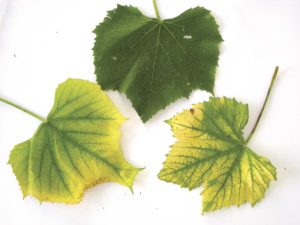
photo courtesy of Washington State University
Chlorosis is a condition in which leaves produce insufficient chlorophyll. As chlorophyll is responsible for the green colour of leaves, chlorotic leaves are pale, yellow, or yellow-white. The affected plant has little or no ability to manufacture carbohydrates through photosynthesis and may die unless the cause of its chlorophyll insufficiency is treated.
Chlorosis is typically caused when leaves don’t have enough nutrients to synthesise all the chlorophyll they need. It can be brought about by a combination of factors including:
- a specific mineral deficiency in the soil, such as iron;
- a high soil pH (alkalinity) at which minerals become unavailable for absorption by the roots
- poor drainage (waterlogged roots)
- damaged and/or compacted roots
- pesticides and particularly herbicides may cause chlorosis, both to target weeds and occasionally to the tree being treated.
- exposure to sulphur dioxide
The lack of iron is one of the more common nutrients associated with chlorosis. Manganese or zinc deficiencies in the plant will also cause chlorosis. The way to separate an iron deficiency from a zinc or manganese deficiency is to check what foliage turned chlorotic first. Iron chlorosis starts on the younger or terminal leaves and later works inward to the older leaves. However, manganese and zinc deficiencies develop on the inner or the older leaves first and then progress outward. Plants need iron for the formation of chlorophyll. Iron is also necessary for many enzyme functions that manage plant metabolism and respiration. Iron becomes more insoluble as the soil pH climbs above 6.5 to 6.7. With most plants, iron can only be absorbed as a free ion (Fe++) when the pH is between 5.0 and 6.5. Other elements such as calcium, zinc, manganese, phosphorus, or copper in high amounts in the soil can tie up iron so that it is unavailable to the plant. However, a shortage of potassium in the plant will reduce the availability of iron to the plant. Insufficient iron in the soil is also (although much less frequently) a problem.
CONTROL
If an immediate result is desired, then a foliar application of ferrous sulphate is needed. Ferrous sulphate should be applied at a rate of 1 oz./gallon of water with a few drops of dish soap added. This method of application allows for the absorption of iron directly by the leaves and results should be seen within ten days. The application of iron chelates or sulphur directly to the root zone is another method of treatment. Results are slower to appear but can last for one to two seasons. The rates of application are on the package. Finally, the soil can and should be amended if iron chlorosis has occurred. Working peatmoss, compost and/or well-rotted manure into the vicinity of the tree or shrub well increase the availability of essential minerals and nutrients. If the iron chlorosis is severe then the combination of the foliar spray and an application of iron chelates to the soil is recommended.
This page was compiled from multiple sources, including the Wikipedia article here, and the University of Illinois Extension office here.
Climb high, Work smart, Read more.
– TreeMuggs
I would love to hear from you. Please send all comments/questions/hatemail to patrick@educatedclimber.com
binance says
Your point of view caught my eye and was very interesting. Thanks. I have a question for you.
sign up for binance says
Can you be more specific about the content of your article? After reading it, I still have some doubts. Hope you can help me.
www.binance.com sign up says
Thank you for your sharing. I am worried that I lack creative ideas. It is your article that makes me full of hope. Thank you. But, I have a question, can you help me?
open a binance account says
Can you be more specific about the content of your article? After reading it, I still have some doubts. Hope you can help me.
registro en Binance says
Thanks for sharing. I read many of your blog posts, cool, your blog is very good.